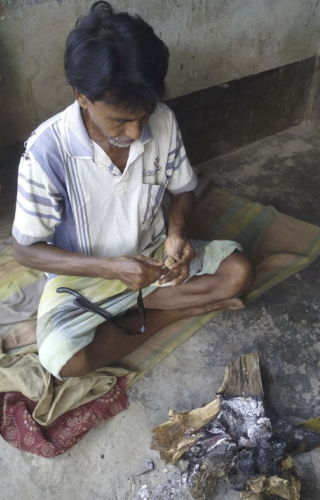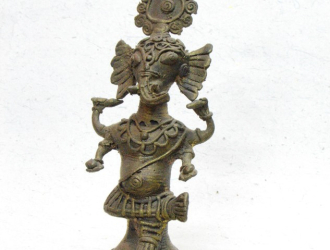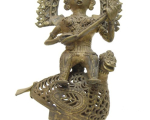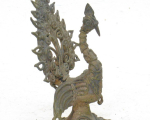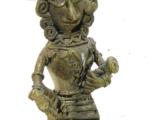The lost-wax metal casting is an ancient craft in India, that has an unbroken tradition of about 5000 years. This technique is commonly practiced for making ritual and utilitarian brass and bronze objects in tribal areas. Traditionally the items made includes utensils, figures of gods and goddesses, equestrian figures, elephants, horse, bulls, birds, lamps and ornaments.
During 1962 the first study of this folk and tribal metal casting tradition was done by researcher Ruth Reeves. The name 'Dhokra' or 'Dokra' was used by her to indicate a community of nomadic craftsmen of Bengal, Orissa and Madhya Pradesh, who made metal utensils, ornaments and votive objects for tribals. But later, this term generically applied to a variety of hand crafted brass objects created by the cire perdue or 'lost wax' process. Often metal objects having texture of lines on their surface, considered as Dhokra Craft.
In December 1015 a group of researcher in their article stated that, ‘Inhabitants of the Indus Valley, the Harappans, developed new techniques in metallurgy (Dhokra). ‘Dokra’ is non–ferrous metal casting using the lost-wax casting technique. Now the ‘Dhokra’ people are settled over a vast tract in the mineral-rich central Indian tribal belt.’ (International Journal of History and Cultural Studies (IJHCS) ISSN Print: 2454-7646, ISSN Online: 2454-7654 Volume 1, Issue 3, Oct - Dec 2015, PP 31-33 www.arcjournals.org ©ARC Page 31 Dhokra: A Traditional Craft of Rural India Sanghamitra Sinha , Druheen Chakrabortty and Malavika Sinha )
Thetari Ranas and Thetari Naiks
I have been working on this subject since 1982 and not found a single craftsman who said that he belongs to Dhokra community or they called their work, Dhokra work. They always said we don’t know why city people called it Dhokra.
In west Bengal metal workers lives in the districts of Bankura, Midnapore, Purulia, Birbhum and Burdwan. Subhas Mandal of Dariapur and Horen Karmkar of Bikna village of Bankura told that we belong to Malar community which now known as Karmkar. They also believed that many years ago their ancestor came in Bengal from Odisha.
In Odisha the metal casting craftsmen of Dhenkanal, Mayrbhanj up to Phoolbani called themselves Sithria or Sithuria Malar, whereas metal casting craftsmen of Koraput, Malkangiri, Umarkot, Raygada and Kalahandi area called themselves as Ghasi and Thetari .
In Jharkhand and Bihar, they are called Malhor.
In Chhattisgarh, they called as Ghasi or Ghadwa in Bastar; Malar in Sarguja and Jhara, Jhorka or Malar in Raigarh area.
In Baitul and Mandla area of Madhya Pradesh they are known as Bhareva. In Bundelkhand area they are called Ajadhia Sunar.
In Nasik and Jalgaon area of Maharashtra, they called Sunar whereas in Ratnagiri area they are known as Otari and Bhareva.
The craft of metal casting is still being practiced in Ushegaon, Jamdaan, Chintalbari, and Chinnedari villages of Adilabad District, Telangana and the artisans belong to Ojha community also known as Wojaris or Ojjis.
Considering above facts we are using term Folk and Tribal Metal Casting instead of Dhokra Metal Casting.
